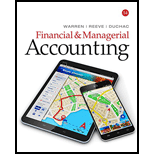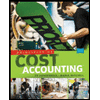
(a)
Absorption Costing
Absorption costing is compulsory under Generally Accepted Accounting Principles (GAAP) for financial statements which are circulated to the external users. The cost of goods manufactured includes direct materials, direct labor, and factory
Variable Costing
Variable costing is the method that is used by the management (managers) for decision making purposes. The cost of goods manufactured includes direct materials, direct labor, and variable factory overhead. Fixed factory overhead is treated as period (fixed) expense.
To Determine: The income statement according to the absorption costing concept for the Y Incorporation.
(a)
Answer to Problem 20.1BPR
Calculate the income statement according to the absorption costing concept for the Y Incorporation as shown below:
| Y Incorporation | ||
| Absorption costing income statement | ||
| for the month ended July, 31 | ||
| Particulars | $ | $ |
| Sales | 2,150,000 | |
| Less: Cost of goods sold | ||
| Cost of goods manufactured | 1,824,000 | |
| Ending inventory (2) | (304,000) | |
| Total cost of goods sold | 1,520,000 | |
| Gross profit | 630,000 | |
| Less: Selling and administrative expenses | 300,000 | |
| Income from operations | 330,000 | |
Table (1)
Explanation of Solution
Working notes:
1. Calculate the value of ending inventory per unit.
2. Calculate the value of ending inventory
Therefore, income from operations under absorption costing concept of Y Incorporation is $330,000.
(b)
The income statement according to the variable cost concept for the Y Incorporation.
(b)
Answer to Problem 20.1BPR
Calculate the income statement according to the variable costing concept for the Y Incorporation as shown below:
| Y Incorporation | ||
| Variable costing income statement | ||
| for the month ended July, 31 | ||
| Particulars | $ | $ |
| Sales | 2,150,000 | |
| Less: Variable cost of goods sold | ||
| Variable cost of goods manufactured (3) | 1,536,000 | |
| Ending inventory (5) | (256,000) | |
| Total variable cost of goods sold | 1,280,000 | |
| Manufacturing margin | 870,000 | |
| Less: Variable selling and administrative expenses | 204,000 | |
| Contribution margin | 666,000 | |
| Less: Fixed costs | ||
| Fixed manufacturing costs | 288,000 | |
| Fixed selling and administrative expenses | 96,000 | |
| Total fixed cost | 384,000 | |
| Income from operations | 282,000 | |
Table (2)
Explanation of Solution
Working note:
1. Calculate cost of goods manufactured
2. Calculate the value of ending inventory per unit.
3. Calculate the value of ending inventory
Therefore, income from operations under variable costing concept of Y Incorporation is $282,000.
(c)
To identify: The reason for the difference between in the amount of income from operations reported in absorption costing income statement and variable costing income statement.
(c)
Explanation of Solution
The difference between the absorption and variable costing income from operations of $48,000
Increase in inventory = 400 units
Fixed factory overhead per unit = $4
Under absorption costing method, the fixed
Under variable costing, all of the fixed factory overhead cost is subtracted in the period in which it is incurred, regardless of the amount of inventory change. Therefore, when inventory rises, the absorption costing income statement will have a higher income from operations than the variable costing income statement.
Want to see more full solutions like this?
Chapter 20 Solutions
Financial & Managerial Accounting
- Can you explain this financial accounting question using accurate calculation methods?arrow_forwardI am looking for help with this financial accounting question using proper accounting standards.arrow_forwardI am looking for help with this general accounting question using proper accounting standards.arrow_forward
- Please provide the correct answer to this financial accounting problem using accurate calculations.arrow_forwardI am searching for the right answer to this financial accounting question using proper techniques.arrow_forwardPlease help me solve this financial accounting question using the right financial principles.arrow_forward
- Can you solve this financial accounting problem with appropriate steps and explanations?arrow_forwardCan you show me the correct approach to solve this financial accounting problem using suitable standards?arrow_forwardI am looking for help with this general accounting question using proper accounting standards.arrow_forward
- I need assistance with this financial accounting problem using valid financial procedures.arrow_forwardPlease provide the correct answer to this general accounting problem using accurate calculations.arrow_forwardPlease provide the correct answer to this general accounting problem using accurate calculations.arrow_forward
 Managerial AccountingAccountingISBN:9781337912020Author:Carl Warren, Ph.d. Cma William B. TaylerPublisher:South-Western College Pub
Managerial AccountingAccountingISBN:9781337912020Author:Carl Warren, Ph.d. Cma William B. TaylerPublisher:South-Western College Pub Managerial Accounting: The Cornerstone of Busines...AccountingISBN:9781337115773Author:Maryanne M. Mowen, Don R. Hansen, Dan L. HeitgerPublisher:Cengage Learning
Managerial Accounting: The Cornerstone of Busines...AccountingISBN:9781337115773Author:Maryanne M. Mowen, Don R. Hansen, Dan L. HeitgerPublisher:Cengage Learning Principles of Cost AccountingAccountingISBN:9781305087408Author:Edward J. Vanderbeck, Maria R. MitchellPublisher:Cengage Learning
Principles of Cost AccountingAccountingISBN:9781305087408Author:Edward J. Vanderbeck, Maria R. MitchellPublisher:Cengage Learning Cornerstones of Cost Management (Cornerstones Ser...AccountingISBN:9781305970663Author:Don R. Hansen, Maryanne M. MowenPublisher:Cengage Learning
Cornerstones of Cost Management (Cornerstones Ser...AccountingISBN:9781305970663Author:Don R. Hansen, Maryanne M. MowenPublisher:Cengage Learning



